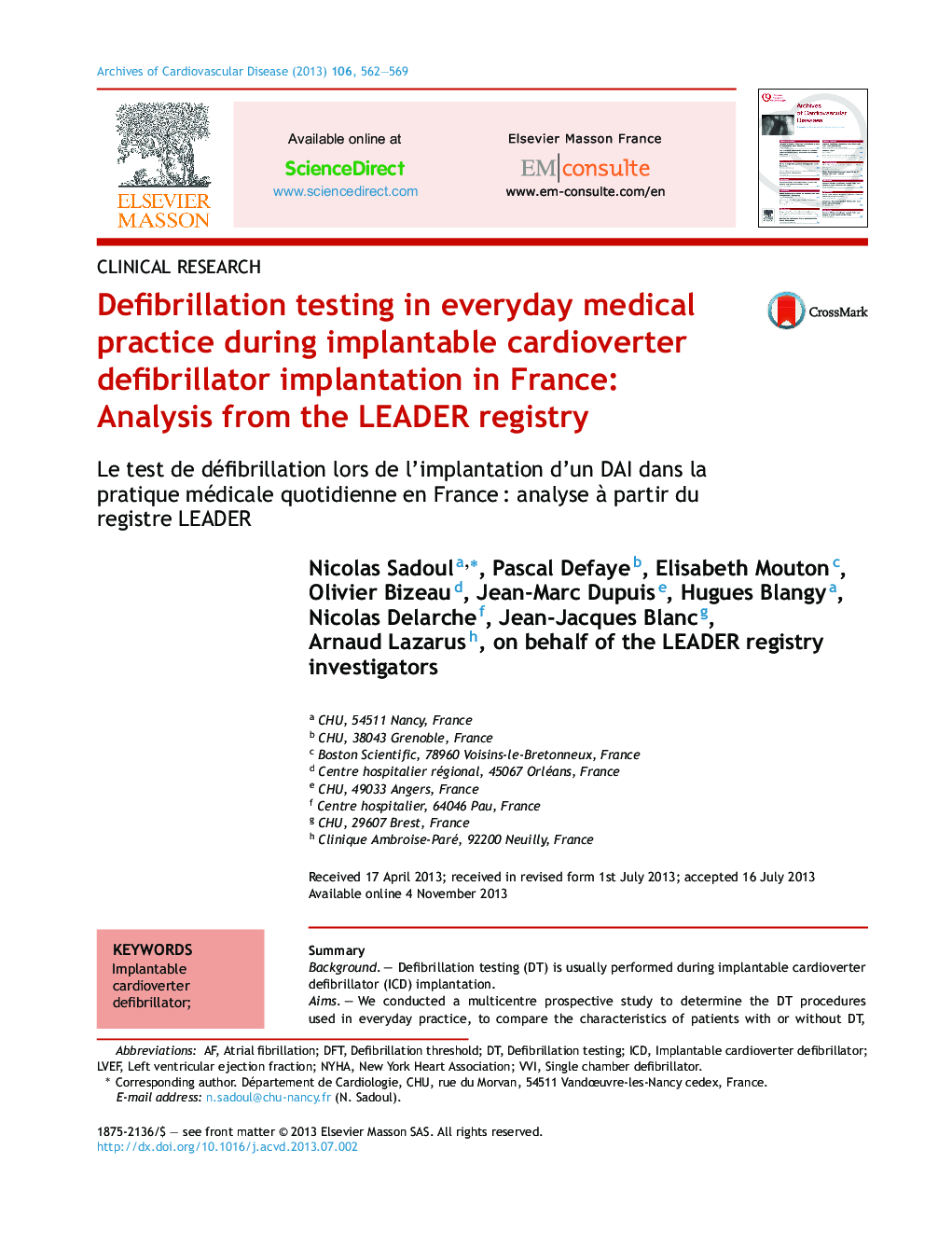| کد مقاله | کد نشریه | سال انتشار | مقاله انگلیسی | نسخه تمام متن |
|---|---|---|---|---|
| 2889133 | 1574360 | 2013 | 8 صفحه PDF | دانلود رایگان |

SummaryBackgroundDefibrillation testing (DT) is usually performed during implantable cardioverter defibrillator (ICD) implantation.AimsWe conducted a multicentre prospective study to determine the DT procedures used in everyday practice, to compare the characteristics of patients with or without DT, and to compare severe adverse events in these two populations during implantation and follow-up.MethodsThe LEADER registry enrolled 904 patients included for primo-implantation of a single (n = 261), dual (n = 230) or triple (n = 429) defibrillation system in 42 French centres.ResultsBaseline characteristics of patients (62.0 ± 13.5 years; 88% men; primary indication 62%) who underwent ventricular fibrillation (VF) induction (VF induction group, n = 810) and those who did not (untested group, n = 94, representing 10.4% of the entire study population) revealed that the untested group were older (P < 0.01), had a lower left ventricular ejection fraction, a wider QRS complex and a higher New York Heart Association class and were more often implanted for primary prevention (P < 0.001 for all). The main reason given for not performing ICD testing was poor haemodynamic condition (59/94). At 1 year, the cumulative survival rate was 95% in tested patients and 85% in untested patients (P < 0.001), mainly because of heart failure deaths. There was one sudden cardiac death in the VF induction group and none in the untested group (P = 1.000).ConclusionsIn this study, more than 10% of ICD patients were implanted without VF induction. Untested patients appeared to be sicker than tested patients, with a more severe long-term outcome, but without any difference in mortality due to arrhythmic events.
RésuméContexteLes tests de défibrillation (DT) sont généralement effectués lors de l’implantation d’un défibrillateur automatique implantable (DAI).ObjectifsCette étude prospective multicentrique a été réalisée afin de : déterminer quelles sont les procédures utilisées pour réaliser les DT dans la « vraie vie » ; comparer les caractéristiques des patients avec ou sans DT ; et comparer les événements secondaires graves entre ces deux populations au cours de l’implantation et du suivi.MéthodesDans le registre LEADER, 904 patients (62,0 ± 13,5 ans ; 88 % hommes, indication primaire = 62 %) ont été inclus dans le cadre d’une primo-implantation d’un système de défibrillation simple (n = 261), double (n = 230) ou triple (n = 429) chambre dans 42 centres français.RésultatsLes caractéristiques de base des patients ayant subi une induction de FV (groupe avec induction de FV, n = 810) et ceux non testés (groupe non testé, n = 94, représentant 10,4 % de l’ensemble de la population de l’étude) a révélé que les patients non testés étaient significativement plus âgés (p < 0,01) et avait une FEVG inférieure, un QRS plus large, une classe NYHA supérieure et ont été plus souvent implantés pour une indication primaire (p < 0,001 pour tous). La principale raison rapportée pour ne pas effectuer les tests de défibrillation était un mauvais état hémodynamique (59/94). Après 1 an, le taux de survie cumulé était de 95 % chez les patients testés contre 85 % chez les patients non testés (p < 0,001), principalement suite à des décès pour insuffisance cardiaque. Il n’y a eu qu’une seule mort subite dans le groupe avec induction de FV et aucune dans le groupe non testé (p = 1,000).ConclusionsDans cette étude multicentrique, > 10 % des patients sont implantés avec un DAI sans induction de VF. Les patients non-testés semblent être de condition plus précaire que les patients testés avec un résultat à long terme plus péjoratif, mais sans différence dans la mortalité due à des événements rythmiques.
Journal: Archives of Cardiovascular Diseases - Volume 106, Issue 11, November 2013, Pages 562–569